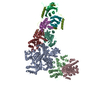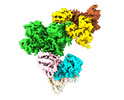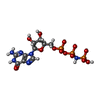+ Open data
Open data
- Basic information
Basic information
| Entry |  | |||||||||
|---|---|---|---|---|---|---|---|---|---|---|
| Title | GATOR1-RAG-RAGULATOR - Inhibitory Complex | |||||||||
 Map data Map data | GATOR1-RAG-RAGULATOR - Inhibitory Complex | |||||||||
 Sample Sample |
| |||||||||
 Keywords Keywords | Complex / GTPase activating protein / nutrient sensing / metabolism / HYDROLASE | |||||||||
| Function / homology |  Function and homology information Function and homology informationGATOR1 complex / regulation of cholesterol import / positive regulation of protein localization to lysosome / regulation of cell-substrate junction organization / negative regulation of kinase activity / regulation of cholesterol efflux / Gtr1-Gtr2 GTPase complex / FNIP-folliculin RagC/D GAP / Ragulator complex / protein localization to cell junction ...GATOR1 complex / regulation of cholesterol import / positive regulation of protein localization to lysosome / regulation of cell-substrate junction organization / negative regulation of kinase activity / regulation of cholesterol efflux / Gtr1-Gtr2 GTPase complex / FNIP-folliculin RagC/D GAP / Ragulator complex / protein localization to cell junction / aorta morphogenesis / regulation of TORC1 signaling / protein localization to lysosome / regulation of TOR signaling / MTOR signalling / fibroblast migration / lysosome localization / Energy dependent regulation of mTOR by LKB1-AMPK / Amino acids regulate mTORC1 / TORC1 signaling / endosome organization / kinase activator activity / protein localization to membrane / cardiac muscle tissue development / vacuolar membrane / endosomal transport / ventricular septum development / lysosome organization / azurophil granule membrane / small GTPase-mediated signal transduction / Macroautophagy / regulation of cell size / RHOJ GTPase cycle / RHOQ GTPase cycle / roof of mouth development / CDC42 GTPase cycle / tertiary granule membrane / mTORC1-mediated signalling / RHOH GTPase cycle / ficolin-1-rich granule membrane / RHOG GTPase cycle / regulation of receptor recycling / RAC2 GTPase cycle / RAC3 GTPase cycle / positive regulation of TOR signaling / enzyme-substrate adaptor activity / response to amino acid / cellular response to nutrient levels / specific granule membrane / protein-membrane adaptor activity / negative regulation of TORC1 signaling / RAC1 GTPase cycle / positive regulation of TORC1 signaling / positive regulation of autophagy / negative regulation of autophagy / RNA splicing / GTPase activator activity / cellular response to amino acid starvation / guanyl-nucleotide exchange factor activity / viral genome replication / cholesterol homeostasis / cellular response to starvation / Regulation of PTEN gene transcription / tumor necrosis factor-mediated signaling pathway / positive regulation of interleukin-8 production / TP53 Regulates Metabolic Genes / cellular response to amino acid stimulus / regulation of cell growth / phosphoprotein binding / MAP2K and MAPK activation / positive regulation of protein localization to nucleus / small GTPase binding / response to virus / GDP binding / late endosome membrane / intracellular protein localization / late endosome / glucose homeostasis / E3 ubiquitin ligases ubiquitinate target proteins / GTPase binding / Hydrolases; Acting on acid anhydrides; Acting on GTP to facilitate cellular and subcellular movement / molecular adaptor activity / lysosome / positive regulation of canonical NF-kappaB signal transduction / positive regulation of MAPK cascade / endosome membrane / intracellular signal transduction / membrane raft / protein heterodimerization activity / lysosomal membrane / focal adhesion / intracellular membrane-bounded organelle / GTPase activity / apoptotic process / DNA-templated transcription / ubiquitin protein ligase binding / Neutrophil degranulation / positive regulation of gene expression / negative regulation of apoptotic process / GTP binding Similarity search - Function | |||||||||
| Biological species |  Homo sapiens (human) Homo sapiens (human) | |||||||||
| Method | single particle reconstruction / cryo EM / Resolution: 4.0 Å | |||||||||
 Authors Authors | Egri SB / Shen K | |||||||||
| Funding support |  United States, 1 items United States, 1 items
| |||||||||
 Citation Citation |  Journal: Mol Cell / Year: 2022 Journal: Mol Cell / Year: 2022Title: Cryo-EM structures of the human GATOR1-Rag-Ragulator complex reveal a spatial-constraint regulated GAP mechanism. Authors: Shawn B Egri / Christna Ouch / Hui-Ting Chou / Zhiheng Yu / Kangkang Song / Chen Xu / Kuang Shen /  Abstract: mTORC1 controls cellular metabolic processes in response to nutrient availability. Amino acid signals are transmitted to mTORC1 through the Rag GTPases, which are localized on the lysosomal surface ...mTORC1 controls cellular metabolic processes in response to nutrient availability. Amino acid signals are transmitted to mTORC1 through the Rag GTPases, which are localized on the lysosomal surface by the Ragulator complex. The Rag GTPases receive amino acid signals from multiple upstream regulators. One negative regulator, GATOR1, is a GTPase activating protein (GAP) for RagA. GATOR1 binds to the Rag GTPases via two modes: an inhibitory mode and a GAP mode. How these two binding interactions coordinate to process amino acid signals is unknown. Here, we resolved three cryo-EM structural models of the GATOR1-Rag-Ragulator complex, with the Rag-Ragulator subcomplex occupying the inhibitory site, the GAP site, and both binding sites simultaneously. When the Rag GTPases bind to GATOR1 at the GAP site, both Rag subunits contact GATOR1 to coordinate their nucleotide loading states. These results reveal a potential GAP mechanism of GATOR1 during the mTORC1 inactivation process. | |||||||||
| History |
|
- Structure visualization
Structure visualization
| Supplemental images |
|---|
- Downloads & links
Downloads & links
-EMDB archive
| Map data |  emd_25652.map.gz emd_25652.map.gz | 306.8 MB |  EMDB map data format EMDB map data format | |
|---|---|---|---|---|
| Header (meta data) |  emd-25652-v30.xml emd-25652-v30.xml emd-25652.xml emd-25652.xml | 25.3 KB 25.3 KB | Display Display |  EMDB header EMDB header |
| Images |  emd_25652.png emd_25652.png | 86.8 KB | ||
| Filedesc metadata |  emd-25652.cif.gz emd-25652.cif.gz | 8.7 KB | ||
| Archive directory |  http://ftp.pdbj.org/pub/emdb/structures/EMD-25652 http://ftp.pdbj.org/pub/emdb/structures/EMD-25652 ftp://ftp.pdbj.org/pub/emdb/structures/EMD-25652 ftp://ftp.pdbj.org/pub/emdb/structures/EMD-25652 | HTTPS FTP |
-Validation report
| Summary document |  emd_25652_validation.pdf.gz emd_25652_validation.pdf.gz | 516.3 KB | Display |  EMDB validaton report EMDB validaton report |
|---|---|---|---|---|
| Full document |  emd_25652_full_validation.pdf.gz emd_25652_full_validation.pdf.gz | 515.8 KB | Display | |
| Data in XML |  emd_25652_validation.xml.gz emd_25652_validation.xml.gz | 7.6 KB | Display | |
| Data in CIF |  emd_25652_validation.cif.gz emd_25652_validation.cif.gz | 8.8 KB | Display | |
| Arichive directory |  https://ftp.pdbj.org/pub/emdb/validation_reports/EMD-25652 https://ftp.pdbj.org/pub/emdb/validation_reports/EMD-25652 ftp://ftp.pdbj.org/pub/emdb/validation_reports/EMD-25652 ftp://ftp.pdbj.org/pub/emdb/validation_reports/EMD-25652 | HTTPS FTP |
-Related structure data
| Related structure data |  7t3aMC  7t3bC  7t3cC M: atomic model generated by this map C: citing same article ( |
|---|---|
| Similar structure data | Similarity search - Function & homology  F&H Search F&H Search |
- Links
Links
| EMDB pages |  EMDB (EBI/PDBe) / EMDB (EBI/PDBe) /  EMDataResource EMDataResource |
|---|---|
| Related items in Molecule of the Month |
- Map
Map
| File |  Download / File: emd_25652.map.gz / Format: CCP4 / Size: 325 MB / Type: IMAGE STORED AS FLOATING POINT NUMBER (4 BYTES) Download / File: emd_25652.map.gz / Format: CCP4 / Size: 325 MB / Type: IMAGE STORED AS FLOATING POINT NUMBER (4 BYTES) | ||||||||||||||||||||||||||||||||||||
|---|---|---|---|---|---|---|---|---|---|---|---|---|---|---|---|---|---|---|---|---|---|---|---|---|---|---|---|---|---|---|---|---|---|---|---|---|---|
| Annotation | GATOR1-RAG-RAGULATOR - Inhibitory Complex | ||||||||||||||||||||||||||||||||||||
| Projections & slices | Image control
Images are generated by Spider. | ||||||||||||||||||||||||||||||||||||
| Voxel size | X=Y=Z: 0.655 Å | ||||||||||||||||||||||||||||||||||||
| Density |
| ||||||||||||||||||||||||||||||||||||
| Symmetry | Space group: 1 | ||||||||||||||||||||||||||||||||||||
| Details | EMDB XML:
|
-Supplemental data
- Sample components
Sample components
+Entire : GATOR1-RAG-RAGULATOR - Inhibitory Complex
+Supramolecule #1: GATOR1-RAG-RAGULATOR - Inhibitory Complex
+Macromolecule #1: GATOR complex protein DEPDC5
+Macromolecule #2: GATOR complex protein NPRL2
+Macromolecule #3: GATOR complex protein NPRL3
+Macromolecule #4: Ras-related GTP-binding protein A
+Macromolecule #5: Ras-related GTP-binding protein C
+Macromolecule #6: Ragulator complex protein LAMTOR1
+Macromolecule #7: Ragulator complex protein LAMTOR2
+Macromolecule #8: Ragulator complex protein LAMTOR3
+Macromolecule #9: Ragulator complex protein LAMTOR4
+Macromolecule #10: Ragulator complex protein LAMTOR5
+Macromolecule #11: PHOSPHOAMINOPHOSPHONIC ACID-GUANYLATE ESTER
-Experimental details
-Structure determination
| Method | cryo EM |
|---|---|
 Processing Processing | single particle reconstruction |
| Aggregation state | particle |
- Sample preparation
Sample preparation
| Buffer | pH: 7.4 |
|---|---|
| Vitrification | Cryogen name: ETHANE |
- Electron microscopy
Electron microscopy
| Microscope | FEI TITAN KRIOS |
|---|---|
| Image recording | Film or detector model: GATAN K2 SUMMIT (4k x 4k) / Average electron dose: 58.3 e/Å2 |
| Electron beam | Acceleration voltage: 300 kV / Electron source:  FIELD EMISSION GUN FIELD EMISSION GUN |
| Electron optics | Illumination mode: FLOOD BEAM / Imaging mode: BRIGHT FIELD / Nominal defocus max: -3.5 µm / Nominal defocus min: -1.0 µm |
| Experimental equipment |  Model: Titan Krios / Image courtesy: FEI Company |
 Movie
Movie Controller
Controller













 Z (Sec.)
Z (Sec.) Y (Row.)
Y (Row.) X (Col.)
X (Col.)





















